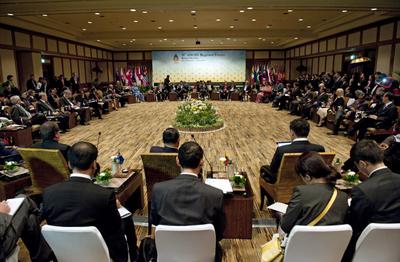Earlier this year, President Susilo Bambang Yudhoyono commented that Indonesia planned to ‘narrow the agenda of the upcoming summit on security and political matters to allow heads of state to solve pressing problems within the region’, while he also proposed that APEC could tackle economic issues. The fact that international financial institutions are not invited to the EAS this year adds to the premise. There now seems to be three specific issues driving the dialogue between leaders: regional cooperation on disaster management, connectivity and maritime cooperation.
The EAS will be preceded by the 19th ASEAN Summit and related meetings, beginning on 13 November, where ASEAN leaders will endorse the Bali Concord III. This agreement, which envisions an ‘ASEAN Community in a Global Community of Nations’ by 2022, will be adopted as ASEAN’s new vision for the future. For its part, the EAS will consist of two two-hour sessions: a plenary session where leaders present speeches reviewing the current direction of the EAS and outlining their thoughts on its future direction, and a retreat session where leaders are given a ‘blank check’ to exchange views on regional and international issues. The Chairman’s statement from the Foreign Ministers’ Consultation in Bali on 22 July provides a background on the ‘old’ agenda of finance, energy, education, avian-flu prevention and disaster management.
During the summit, Indonesia will launch an unofficial commentary, or non-paper, on a ‘Practical Approach to Enhance Regional Cooperation on Disaster Rapid Response’, and Australia will also release one on ‘Disaster Management and Response in the EAS’. Indonesia’s Minister of Foreign Affairs, Marty Natalegawa, will also initiate a real-time information-sharing portal stationed at the ASEAN Coordinating Centre for Humanitarian Assistance on Disaster Management that will link to all EAS member states and international agencies like the UN. In this vein, the EAS will seek to address bureaucratic bottlenecks on disaster-relief efforts, including visa, customs and quarantine issues. But despite these initiatives, the challenge remains as to whether the region can be better equipped to withstand ‘megadisasters’ like Japan’s triple disaster earlier this year, the 2004 Indian Ocean tsunami or Myanmar’s Cyclone Nargis through such measures? With all EAS member states supporting these disaster-management initiatives, concrete deliverables are possible.
Connectivity is another area on which regional leaders are expected to focus. A successful implementation of the Master Plan on ASEAN Connectivity is in the interest of both ASEAN and non-ASEAN EAS member states. Regional (and also global) growth potential will not be optimised without it. Physical-connectivity discussions will potentially look beyond the scope of the Master Plan to include connectivity between ASEAN and non-ASEAN states. Maritime connectivity between ASEAN and Australia or New Zealand is one example of this. Negative effects on regional connectivity like transnational crime, terrorism and pollution will also be a part of this agenda. Meanwhile, institutional connectivity (including trade facilitation and trade financing) and people-to-people connectivity will remain internally discussed within ASEAN.
The last apparent area — maritime cooperation — is more subtle. It consists of diplomatically sensitive issues, including the South China Sea, and less-sensitive issues like piracy, people smuggling and transnational crime. In its simplest form, the EAS aims to transform conflicts into cooperation, tensions into peace, and threats into partnership. As a ‘benign’ organisation that ‘threatens none, but comforts all’, ASEAN is a key multilateral organisation. And the ASEAN-led EAS is important in bringing together China and the US, two countries whose relationship is often characterised by tension, let alone other regional players. This is not to say that ASEAN itself is free of conflict. But its stability as an institution for over 44 years and its visible maturing over this time is testimony that ASEAN serves as a regional power-broker and conciliator. Its maintenance of a ‘dynamic equilibrium’ in the region by avoiding the hegemony of any power also supports a successful and fluid regionalism, including the emergence of fora like the EAS.
ASEAN members should not miss an opportunity to contribute toward regional prosperity, peace and stability at this year’s EAS. And the EAS, in turn, must avoid becoming a simple ‘talk shop’ but develop into a key regional platform complying with common global rules, norms and principles, reinforced by deepening economic cooperation. A sense of community, solidarity and unity — ASEAN’s greatest offering — must not be lost; it must be promoted beyond the organisation. Asia is one of a handful of regions that remain economically prosperous, peaceful and socially stable, and every effort must be made to maintain it this way.
Maria Monica Wihardja is a Researcher at the Centre for Strategic and International Studies, Jakarta, and a Lecturer at the Department of Economics, University of Indonesia.

